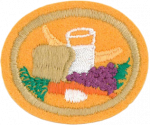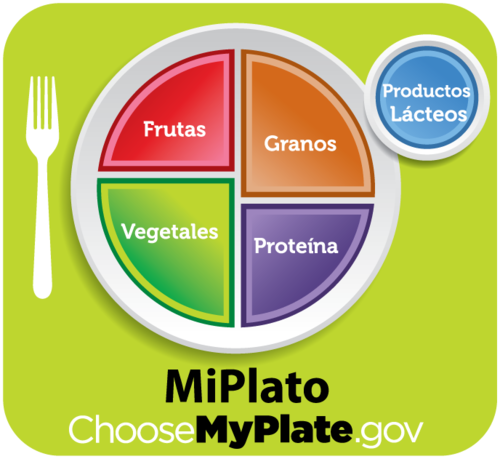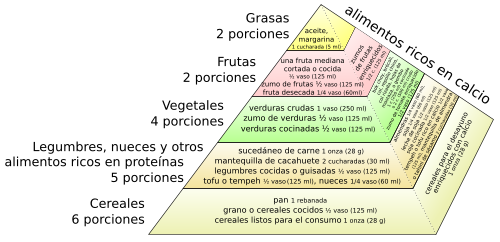Difference between revisions of "AY Honors/Nutrition/Answer Key 2/es"
(Created page with "</noinclude> <!-- 7. Nombrar tres enfermedades comunes que pueden ser controladas por la dieta. -->") |
(Created page with "'''Diabetes:''' Las formas más importantes de la diabetes se deben a la disminuida o ausencia total de la producción de insulina (diabetes tipo 1), o la disminución de la s...") |
||
| Line 247: | Line 247: | ||
<!-- 7. Nombrar tres enfermedades comunes que pueden ser controladas por la dieta. --> | <!-- 7. Nombrar tres enfermedades comunes que pueden ser controladas por la dieta. --> | ||
| − | '''Diabetes:''' | + | '''Diabetes:''' Las formas más importantes de la diabetes se deben a la disminuida o ausencia total de la producción de insulina (diabetes tipo 1), o la disminución de la sensibilidad de los tejidos del cuerpo a la insulina (tipo 2, la forma más común). El primero requiere inyecciones de insulina para sobrevivir; este último es generalmente administrado con la dieta, la reducción de peso y ejercicio en aproximadamente 20% de los casos, aunque la mayoría requieren estas estrategias más la medicación oral (la insulina se utiliza si los comprimidos son ineficaces). |
'''Cardiovascular Disease:''' Attempts to prevent cardiovascular disease take the form of modifying risk factors. Some, such as gender, age, and family history, cannot be modified. Smoking cessation (or abstinence) is one of the most effective and easily modifiable changes. Also important is a low-fat, low-calorie diet, which helps one to maintain a healthy body mass index (BMI) and preventing obesity. Regular cardiovascular exercise (aerobic exercise) complements the healthful eating habits. Sometimes, the combination of diet and exercise will improve lipoprotein (cholesterol) levels; if not, a physician may prescribe "cholesterol-lowering" drugs, such as the statins. Treatment of cardiovascular disease depends on the specific form of the disease in each patient, but effective treatment always includes preventative lifestyle changes discussed above. Medications, such as blood pressure reducing medications, aspirin and other treatments may be involved. | '''Cardiovascular Disease:''' Attempts to prevent cardiovascular disease take the form of modifying risk factors. Some, such as gender, age, and family history, cannot be modified. Smoking cessation (or abstinence) is one of the most effective and easily modifiable changes. Also important is a low-fat, low-calorie diet, which helps one to maintain a healthy body mass index (BMI) and preventing obesity. Regular cardiovascular exercise (aerobic exercise) complements the healthful eating habits. Sometimes, the combination of diet and exercise will improve lipoprotein (cholesterol) levels; if not, a physician may prescribe "cholesterol-lowering" drugs, such as the statins. Treatment of cardiovascular disease depends on the specific form of the disease in each patient, but effective treatment always includes preventative lifestyle changes discussed above. Medications, such as blood pressure reducing medications, aspirin and other treatments may be involved. | ||
Revision as of 13:58, 16 February 2021
| Nutrición | ||
|---|---|---|
| División Norteamericana
|
Destreza: 1 Año de introducción: 1981 |
|
Requisitos
|
La especialidad de Nutrición es un componente de la Maestría Artes Domésticas. |
| Conexión Logros para la Investidura: Esta especialidad está relacionada con los requisitos de Logros para la Investidura para AMIGO Salud y aptitiud física que requiere cumplir los requisitos #1 y #6 de esta especialidad. Un requisito de GUÍA salud y aptitud Física puede cumplirse después de enseñar los requisitos #1 y #6 de esta especialidad. |
La guía pirámide de alimentos es actualizado y publicado por el Departamento de Agricultura de Estados Unidos (USDA). Se sustituyó la pirámide alimenticia con «MiPlato» en 2011. La pirámide de los alimentos ya no es promulgada por el gobierno de EE.UU.
Si desea continuar la enseñanza del concepto de la pirámide de los alimentos, se puede usar la pirámide vegana de alimentos en su lugar. Ambos se muestran a continuación:
El prefijo lacto significa leche o lácteo, y se puede encontrar en las palabras tales como lactosa (un químico que se encuentra en la leche).
El prefijo ovo significa huevo y se puede encontrar en las palabras tales como ovales (que significa en forma de huevo).
Estos prefijos se utilizan para describir las excepciones a una dieta vegetariana como sigue:
Un ovolactovegetariano es una persona que come ningún producto animal (como la carne) excepto la leche (y los productos lácteos como queso, helados y yogur) y los huevos.
Un ovovegetariano es una persona que come ningún producto animal (no carne ni leche) excepto los huevos.
Un vegano es un vegetariano que come ningún producto animal en absoluto.
Para utilizar la versión actual de la pirámide de alimentos del USDA, primero debe ir a ChooseMyPlate.gov (MiPlato) e introduzca la información del Conquistador (edad, sexo y actividad física). Esto le dirá qué cantidad de cada categoría de alimentos del Conquistador debe comer.
Los valores en la tabla de abajo son para los niños que son físicamente activos durante 60 minutos o más por día. Utilice el sitio web del USDA para los adultos y los niños menos activos.
| Grupo alimenticio | Graanos | Vegetales | Frutas | Lácteos | Carnes y legumbres |
| Varón de 10 años | 7 onzas | 3 tazas | 2 tazas | 3 tazas | 6 onzas |
|---|---|---|---|---|---|
| Dama de 10 años | 6 onzas | 2.5 cups | 2 tazas | 3 tazas | 5.5 onzas |
| Varón de 11 años | 7 onzas | 3 tazas | 2 tazas | 3 tazas | 6 onzas |
| Dama de 11 años | 6 onzas | 2.5 tazas | 2 tazas | 3 tazas | 5.5 onzas |
| Varón de 12 años | 8 onzas | 3 tazas | 2 tazas | 3 tazas | 6.5 onzas |
| Dama de 12 años | 7 onzas | 3 tazas | 2 tazas | 3 tazas | 6 onzas |
| Varón de 13 años | 9 onzas | 3.5 tazas | 2 tazas | 3 tazas | 6.5 onzas |
| Dama de 13 años | 7 onzas | 3 tazas | 2 tazas | 3 tazas | 6 onzas |
| Varón de 14 años | 10 onzas | 3.5 tazas | 2.5 tazas | 3 tazas | 7 onzas |
| Dama de 14 años | 8 onzas | 3 tazas | 2 tazas | 3 tazas | 6.5 onzas |
| Varón de 15 años | 10 onzas | 5 tazas | 2.5 tazas | 3 tazas | 7 onzas |
| Dama de 15 años | 8 onzas | 3 tazas | 2 tazas | 3 tazas | 6.5 onzas |
Conocido también como tiamina. El beriberi es una enfermedad causada por la deficiencia de la vitamina B1.
Conocido también como riboflavina. Se requiere para la formación de glóbulos rojos.
Las frutas cítricas (lima, limón, naranja, pomelo), los tomates y las papas son buenas fuentes comunes de vitamina C. Otros alimentos que son buenas fuentes de vitamina C incluyen la papaya, brócoli, coles de Bruselas, grosellas negras, fresas, coliflor, espinaca, melón y kiwi. Además, los arándanos y pimientos rojos son buenas fuentes de la vitamina.
La leche y los huevos son ambas fuentes animales de vitamina A. Las zanahorias y las espinacas son buenas fuentes vegetales de vitamina A.
Buenas fuentes de vitamina B1 incluyen cereales integrales (trigo, avena, arroz, etc.), albaricoques, piñas, legumbres, hojas de nabo y los pistachos.
Leche, queso, verduras de hoja verde, hígado, levadura, almendras y semillas de soja maduras son buenas fuentes de vitamina B2, pero la exposición a la luz destruirán la riboflavina en estas fuentes naturales.
Buenas fuentes de hierro en la dieta son las carnes, pescado, aves, lentejas, frijoles, verduras de hoja, queso de soja, garbanzos, guisantes de ojo negro, las fresas y la farina.
Los productos lácteos, como la leche y el queso, son una fuente bien conocida de calcio. Sin embargo, algunas personas son alérgicas a los productos lácteos e incluso más personas, en particular los de origen no europeo, son intolerantes a la lactosa, lo que les impide consumir productos lácteos. Afortunadamente, existen muchas otras buenas fuentes de calcio. Esto incluye los frutos secos y las semillas (como las almendras y sésamo), frijoles; trigo integral; berza; okra; nabo sueco; brócoli; y productos fortificados como el jugo de naranja y pan.
Es importante beber mucha agua para que no se deshidrate. Su cuerpo necesita agua para ayudar a eliminar los residuos y para mantener las células en el cuerpo hidratado.
Debe beber agua cuando tenga sed. Un mito persistente es que una persona necesita beber 8 vasos de ocho onzas de agua cada día. Mientras que seguir esta regla causará ningún daño, no es soportada por evidencia científica. Una persona debe reemplazar la misma cantidad de agua que pierde en un día. El agua se pierde por la orina, la eliminación intestinal, la sudoración y la respiración. Recuerde que beber no es la única manera de reemplazar el agua perdida: el alimento contiene una gran cantidad de agua y su cuerpo puede absorber agua a través de la piel. Una vez más, la regla general es beber agua cuando tenga sed o siempre que desee agua.
Diabetes: Las formas más importantes de la diabetes se deben a la disminuida o ausencia total de la producción de insulina (diabetes tipo 1), o la disminución de la sensibilidad de los tejidos del cuerpo a la insulina (tipo 2, la forma más común). El primero requiere inyecciones de insulina para sobrevivir; este último es generalmente administrado con la dieta, la reducción de peso y ejercicio en aproximadamente 20% de los casos, aunque la mayoría requieren estas estrategias más la medicación oral (la insulina se utiliza si los comprimidos son ineficaces).
Cardiovascular Disease: Attempts to prevent cardiovascular disease take the form of modifying risk factors. Some, such as gender, age, and family history, cannot be modified. Smoking cessation (or abstinence) is one of the most effective and easily modifiable changes. Also important is a low-fat, low-calorie diet, which helps one to maintain a healthy body mass index (BMI) and preventing obesity. Regular cardiovascular exercise (aerobic exercise) complements the healthful eating habits. Sometimes, the combination of diet and exercise will improve lipoprotein (cholesterol) levels; if not, a physician may prescribe "cholesterol-lowering" drugs, such as the statins. Treatment of cardiovascular disease depends on the specific form of the disease in each patient, but effective treatment always includes preventative lifestyle changes discussed above. Medications, such as blood pressure reducing medications, aspirin and other treatments may be involved.
Cancer: The consensus on diet and cancer is that obesity increases the risk of developing cancer. Particular dietary practices often explain differences in cancer incidence in different countries (e.g. gastric cancer is more common in Japan, while colon cancer is more common in the United States). Studies have shown that immigrants develop the risk of their new country, suggesting a link between diet and cancer rather than a genetic basis.
The two biggest differences between white bread and whole wheat are the processing and the nutritional value. Whole wheat flour has the higher nutritive value.
Flour is made from wheat berries. The wheat berry is made up of the bran, the germ and the endosperm. All parts are filled with nutrients and are used in whole wheat flour.
White bread on the other hand, uses only the endosperm - the starchy inner layer. There are a total of 30 nutrients present in whole wheat bread that are missing in white bread. The nutritional difference is immense and has measurable impact on our health.
The fiber content of whole wheat bread has several health benefits.
Fiber helps the digestive system. It also creates a 'full' sensation and thus can help with weight control. Research has been conducted by Harvard and other organizations that shows men and women who eat high-fiber foods are less likely to have heart attacks and strokes as compared to those who don't.
There is also an increased risk of diabetes in children who eat refined white flour - a risk that has been proven by the increase in cases of childhood diabetes.
The daily dietary intake level of a nutrient that is considered sufficient to meet the requirements of nearly all (97-98%) healthy individuals in each life-stage and gender group. These are established by the Food and Nutrition Board of the (US) National Academy of Sciences.
Fat-soluble vitamins may be stored in the body and can cause toxicity when taken in excess. Water-soluble vitamins are not stored in the body, with the exception of Vitamin B12, which is stored in the liver.
Some of the most common causes of vitamin poisoning are vitamins A, B3 and B6. Conversely, certain vitamins do not produce toxicity in excess levels: vitamin C has been used in clinical trials in dosages over 100,000 mg — over 1000 times the daily recommended intake — without ill effects.
Excess doses of mineral supplements can also lead to poisoning. Either or both of vitamin poisoning and mineral supplement poisoning can occur due to excessive intake of multivitamin supplements.
References
- Wikipedia article on Recommended Dietary Allowance
- Wikipedia article on Vitamins
- Wikipedia article on Vitamin Poisoning
- Wikipedia article on Cancer
- Wikipedia article on Cardiovascular Disease
- Wikipedia article on Diabetes
- ChooseMyPlate.gov
- VitaminsDiary.com
- Categoría: Tiene imagen de insignia
- Adventist Youth Honors Answer Book/Honors/es
- Adventist Youth Honors Answer Book/es
- Adventist Youth Honors Answer Book/Skill Level 1/es
- Categoría: Libro de respuestas de especialidades JA/Especialidades introducidas en 1981
- Adventist Youth Honors Answer Book/North American Division/es
- Adventist Youth Honors Answer Book/Household Arts/es
- Adventist Youth Honors Answer Book/Household Arts/Primary/es
- Adventist Youth Honors Answer Book/Homemaking Master Award/es
- Adventist Youth Honors Answer Book/Stage 100/es
- Adventist Youth Honors Answer Book/IAConnection/es
- Adventist Youth Honors Answer Book
- Adventist Youth Honors Answer Book/Do at home




